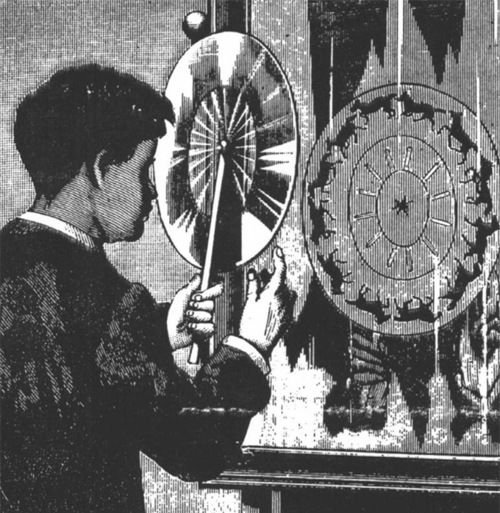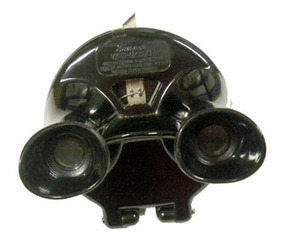 My parents will correct me if I’m wrong, but I didn’t have a doll house when I was little.
My parents will correct me if I’m wrong, but I didn’t have a doll house when I was little.
At my grandma’s house, there was my aunt’s old metal dollhouse… And I had Barbie houses and the like. But I never had a real dollhouse, a real miniature world of my own… Until now.
At an recent auction, there were a number of vintage and antique toys, including two vintage paper dollhouses. I was fascinated because, frankly, I’d never seen a paper doll house.
But I figured both old dollhouses would go for more than I had to spend in total that day, and so the auction viewing was as close as I would get.
However, when the first vintage dollhouse (the one made of pressed paper board, shown on the left in the photo) went cheap, I was hopeful — and managed to win the other!

While I don’t have any dolls or furnishings for my new-to-me old toy, I now had the opportunity to learn more about the history of paper dollhouses.
As you can see, my vintage dollhouse is made of paper — a thick paper, thicker than the usual business card, but thinner than the standard cardboard; as opposed to the thicker pressed paper or fiberboard of the larger house at the auction.

Neither dollhouse had any obvious marking for maker, etc., and as I’m reluctant to handle such fragile things (especially when I can’t imagine I’ll be able to bid on them), I didn’t dare hoist them in the air for a closer inspection. (And so I know nothing about the larger house.) But when I got mine home…

Well, closer inspection brought no further help in terms of maker; so it was research time.
Grasping at straws, I searched for paper dollhouses, Tudor paper dollhouses, etc., and eventually got lucky, finding this 1947 advertisement from the December issue of Children’s Activities for a fiberboard house by Built-Rite of Indiana.

Now that I knew the name of the manufacturer of the vintage chromolithographed cardboard dollhouse, I could really find out more.
The Built-Rite name belongs to Warren Paper Products Company, a company founded in 1921 by Donald M. Warren as a manufacturer of paper boxes for makers of candy, apparel, jewelry, and other items.
name belongs to Warren Paper Products Company, a company founded in 1921 by Donald M. Warren as a manufacturer of paper boxes for makers of candy, apparel, jewelry, and other items.
By the 1930s, The Great Depression meant the need for cheap toys in the United States and Canada. Not only did paper mean a less expensive toy, but toys made by North American companies would be cheaper than toys shipped from Germany. This created a demand for toys that Warren Paper Products and other companies were happy to fill.
and other companies were happy to fill.
The advances made in color printing in the late 19th century, meant that elaborate architectural details could be depicted on flat surfaces. According to Gunn Historical Musem, “This offered an ideal medium for toy villages. Individual buildings were printed on heavy paper or cardboard that could then be compactly folded for shipping, then assembled by a child.”

As you can see from my vintage paper dollhouse, and the following photos of another vintage Built-Rite dollhouse (sold as a “toy house play set”), assembly was a simply a matter of unfolding the structure, popping out pieces along their perforated edges (mine even has several types of bushes, a cat and a dog!), placing the tabs into the slots, and setting the house up on the bottom of the box it came in.




Warren Paper Products was the leader in this market, presumably, at least in part, due to its patented in 1932. But there were competitors, such as Andrews, Durrel Co., Gables House & Carton Co., Grimm & Leeds Co., Jayline Toys Inc., Marx Toys, McLoughlin Brothers, Sutherland Paper Company, Transogram, and Wayne Paper Products.
By the time World War II began, disrupting the flow of toys from Germany, plastics was becoming the word — but toys made of paper, and toys made of wood, cloth, etc., jazzed-up with colorful printed papers, were still very popular too.
Not only did the demand for paper dollhouses increase, but during the 1940s and 1950s Warren Paper Products began manufacturing paper towns, forts, farms, airports, bridges, trees for toy trains as well as forts, railroads stations, farms and airports
Many of these paper dollhouses by Warren Paper were built as replicas of actual homes and they were marketed though Life Magazine and Time/Life, Inc. as a selling tool for the magazine’s house plans after the war (to house the baby boom). Which rather inspires a whole other bit of investigation.
And here I thought I’d just have to invest in some vintage dolls and dollhouse furniture, etc.; turns out, I’m right back to my vintage magazines again!
Image credits:
All images are my own (and may be used if properly credited), except for the vintage ad, which was via Jennifer McKendry’s antique dollhouse site, and the Vintage Built-Rite Toy House Play Set No 34 photos are via Nine Caroline Antiques.






















